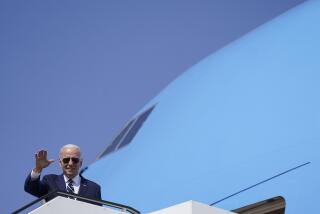Refining a Vision of Trade : U.S. interest in Asia-Pacific is keen but its approach is still taking shape
- Share via
Nowhere is President Clinton’s attempt to put U.S. economic interests at the heart of foreign policy more evident than in his approach to the Asia-Pacific region. It is perhaps the Administration’s most intriguing and pro-active foreign policy initiative to date. But the new strategic focus on Asia will require special precision and follow-through.
Clinton’s historic meeting with leaders of Asia-Pacific countries last weekend put the nation and world on notice that the Administration is keenly interested in the region, the world’s fastest-growing. The Asia Pacific Economic Cooperation meeting in Seattle provided a symbolic opportunity for the President to reiterate his call of last July for a “new Pacific community.”
Clearly it is in U.S. economic interests to increase trade with Asia-Pacific nations. More exports to that part of the world would translate into more jobs and business for American firms. The challenge now is for the United States to move onward with a substantive Asia-Pacific agenda.
Some skeptics saw the Seattle meeting as no more than a photo opportunity and a means for the Administration to signal the European Community, now known as the European Union, that if the EU fails to act to successfully conclude world trade talks by the Dec. 15 deadline, the United States can turn to Pacific commerce.
The Administration is seeking a multilateral forum to expand trade in the Asia-Pacific region. But is APEC the best vehicle?
As host of this year’s APEC meeting, the Administration used the gathering to acknowledge the Asia-Pacific region’s fast-rising fortunes and its importance to the global economy. But the fledging APEC, begun just four years ago, has played a largely consultative and consensus role for its 17 member nations. The Administration thinks APEC could take on a policy-making role, particularly in liberalizing trade.
Indeed, an APEC committee did recommend creation of a free-trade zone throughout the Pacific as well as changing the last word in APEC’s name from cooperation to community. But APEC members delayed consideration of the package containing those ideas. Asian nations--diverse in language, culture, politics and economic development--are not quite ready to embrace the notion of a “community.” To them, the proposed word change conjures up a negative image of total economic integration akin to the goal of the EU.
Meanwhile, the success of the U.S. approach to the region will depend heavily on Japan and China, which together account for two-thirds of the U.S. global trade deficit. The Administration has said the U.S.-Japan relationship is the cornerstone of its broader Asia-Pacific policy. Clinton’s success in ongoing bilateral trade talks with Japan could be the litmus test for his Asia-Pacific vision.
More to Read
Get the L.A. Times Politics newsletter
Deeply reported insights into legislation, politics and policy from Sacramento, Washington and beyond. In your inbox twice per week.
You may occasionally receive promotional content from the Los Angeles Times.










